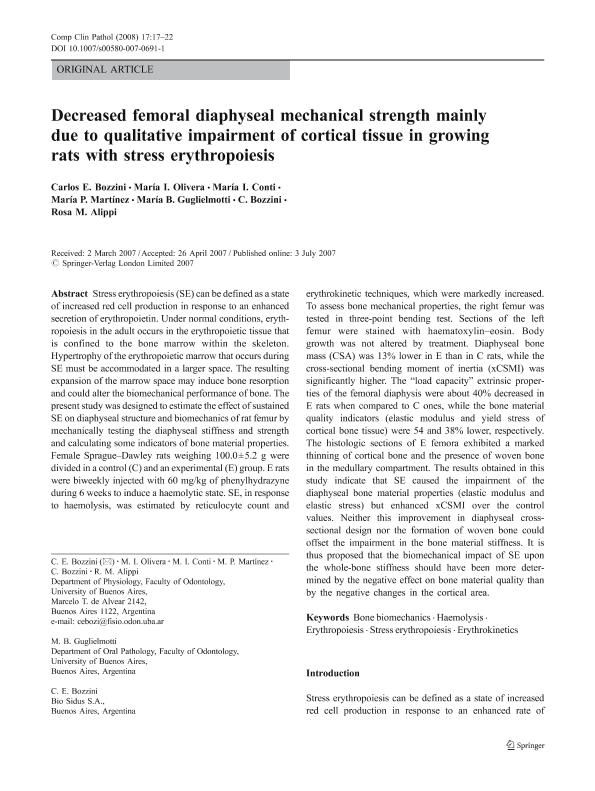Mostrar el registro sencillo del ítem
dc.contributor.author
Bozzini, Carlos Eduardo Jose

dc.contributor.author
Olivera, María I.
dc.contributor.author
Conti, Maria Ines

dc.contributor.author
Martinez, Maria del Pilar

dc.contributor.author
Guglielmotti, Maria Beatriz

dc.contributor.author
Bozzini, C.
dc.contributor.author
Alippi, Rosa Maria

dc.date.available
2022-06-28T17:03:01Z
dc.date.issued
2008-12
dc.identifier.citation
Bozzini, Carlos Eduardo Jose; Olivera, María I.; Conti, Maria Ines; Martinez, Maria del Pilar; Guglielmotti, Maria Beatriz; et al.; Decreased femoral diaphyseal mechanical strength mainly due to qualitative impairment of cortical tissue in growing rats with stress erythropoiesis; Springer; Comparative Clinical Pathology; 17; 1; 12-2008; 17-22
dc.identifier.issn
1618-5641
dc.identifier.uri
http://hdl.handle.net/11336/160670
dc.description.abstract
Stress erythropoiesis (SE) can be defined as a state of increased red cell production in response to an enhanced secretion of erythropoietin. Under normal conditions, erythropoiesis in the adult occurs in the erythropoietic tissue that is confined to the bone marrow within the skeleton. Hypertrophy of the erythropoietic marrow that occurs during SE must be accommodated in a larger space. The resulting expansion of the marrow space may induce bone resorption and could alter the biomechanical performance of bone. The present study was designed to estimate the effect of sustained SE on diaphyseal structure and biomechanics of rat femur by mechanically testing the diaphyseal stiffness and strength and calculating some indicators of bone material properties. Female Sprague - Dawley rats weighing 100.0±5.2 g were divided in a control (C) and an experimental (E) group. E rats were biweekly injected with 60 mg/kg of phenylhydrazyne during 6 weeks to induce a haemolytic state. SE, in response to haemolysis, was estimated by reticulocyte count and erythrokinetic techniques, which were markedly increased. To assess bone mechanical properties, the right femur was tested in three-point bending test. Sections of the left femur were stained with haematoxylin - eosin. Body growth was not altered by treatment. Diaphyseal bone mass (CSA) was 13% lower in E than in C rats, while the cross-sectional bending moment of inertia (xCSMI) was significantly higher. The "load capacity" extrinsic properties of the femoral diaphysis were about 40% decreased in E rats when compared to C ones, while the bone material quality indicators (elastic modulus and yield stress of cortical bone tissue) were 54 and 38% lower, respectively. The histologic sections of E femora exhibited a marked thinning of cortical bone and the presence of woven bone in the medullary compartment. The results obtained in this study indicate that SE caused the impairment of the diaphyseal bone material properties (elastic modulus and elastic stress) but enhanced xCSMI over the control values. Neither this improvement in diaphyseal cross-sectional design nor the formation of woven bone could offset the impairment in the bone material stiffness. It is thus proposed that the biomechanical impact of SE upon the whole-bone stiffness should have been more determined by the negative effect on bone material quality than by the negative changes in the cortical area.
dc.format
application/pdf
dc.language.iso
eng
dc.publisher
Springer

dc.rights
info:eu-repo/semantics/openAccess
dc.rights.uri
https://creativecommons.org/licenses/by-nc-sa/2.5/ar/
dc.subject
BONE BIOMECHANICS
dc.subject
ERYTHROKINETICS
dc.subject
ERYTHROPOIESIS
dc.subject
HAEMOLYSIS
dc.subject
STRESSERYTHROPOIESIS
dc.title
Decreased femoral diaphyseal mechanical strength mainly due to qualitative impairment of cortical tissue in growing rats with stress erythropoiesis
dc.type
info:eu-repo/semantics/article
dc.type
info:ar-repo/semantics/artículo
dc.type
info:eu-repo/semantics/publishedVersion
dc.date.updated
2022-06-21T18:39:27Z
dc.identifier.eissn
1618-565X
dc.journal.volume
17
dc.journal.number
1
dc.journal.pagination
17-22
dc.journal.pais
Reino Unido

dc.journal.ciudad
Londres
dc.description.fil
Fil: Bozzini, Carlos Eduardo Jose. Universidad de Buenos Aires. Facultad de Odontología. Cátedra de Fisiología; Argentina. Consejo Nacional de Investigaciones Científicas y Técnicas. Oficina de Coordinación Administrativa Houssay; Argentina
dc.description.fil
Fil: Olivera, María I.. Universidad de Buenos Aires. Facultad de Odontología. Cátedra de Fisiología; Argentina
dc.description.fil
Fil: Conti, Maria Ines. Universidad de Buenos Aires. Facultad de Odontología. Cátedra de Fisiología; Argentina. Consejo Nacional de Investigaciones Científicas y Técnicas. Oficina de Coordinación Administrativa Houssay; Argentina
dc.description.fil
Fil: Martinez, Maria del Pilar. Universidad de Buenos Aires. Facultad de Odontología. Cátedra de Fisiología; Argentina. Consejo Nacional de Investigaciones Científicas y Técnicas. Oficina de Coordinación Administrativa Houssay; Argentina
dc.description.fil
Fil: Guglielmotti, Maria Beatriz. Consejo Nacional de Investigaciones Científicas y Técnicas. Oficina de Coordinación Administrativa Houssay; Argentina. Universidad Nacional de Cordoba. Facultad de Odontologia. Departamento de Biologia Bucal; Argentina
dc.description.fil
Fil: Bozzini, C.. Universidad de Buenos Aires. Facultad de Odontología. Cátedra de Fisiología; Argentina
dc.description.fil
Fil: Alippi, Rosa Maria. Universidad de Buenos Aires. Facultad de Odontología. Cátedra de Fisiología; Argentina. Consejo Nacional de Investigaciones Científicas y Técnicas. Oficina de Coordinación Administrativa Houssay; Argentina
dc.journal.title
Comparative Clinical Pathology
dc.relation.alternativeid
info:eu-repo/semantics/altIdentifier/url/https://link.springer.com/article/10.1007/s00580-007-0691-1
dc.relation.alternativeid
info:eu-repo/semantics/altIdentifier/doi/http://dx.doi.org/10.1007/s00580-007-0691-1
Archivos asociados
